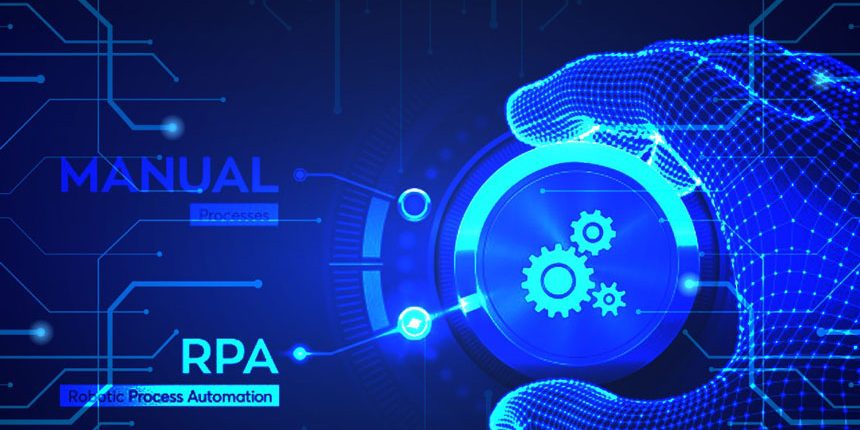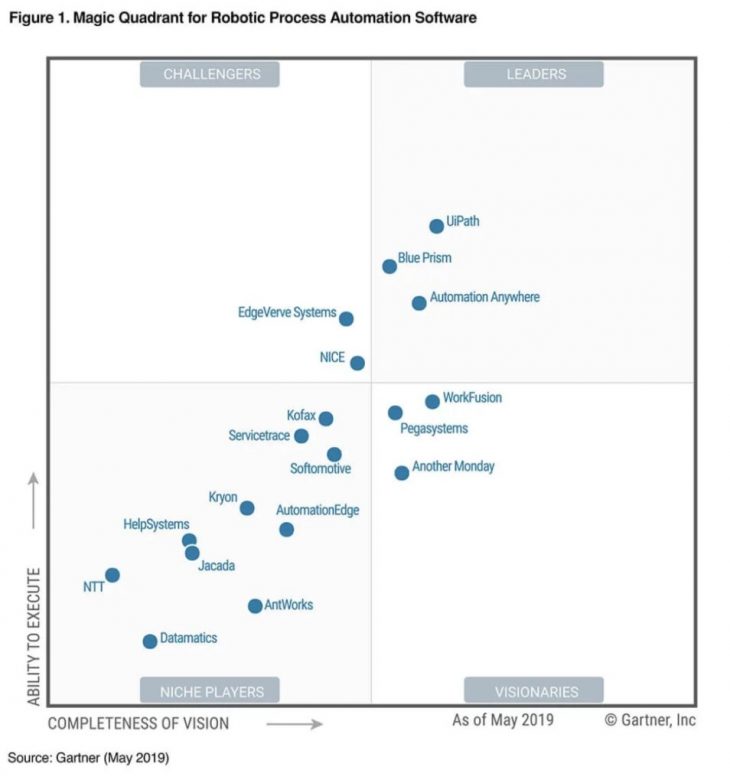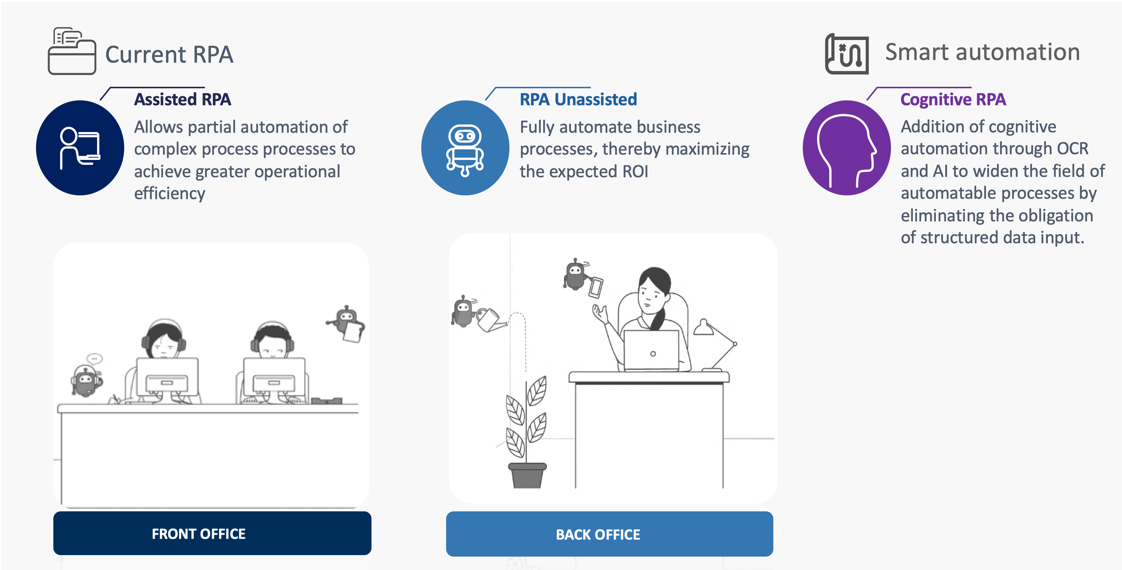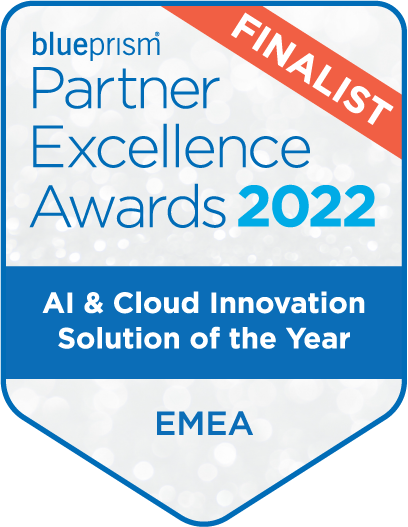Digitalisation is no longer an option. Since remote working has become the norm, companies need to find new solutions to optimise their business processes and gain efficiency. The pandemic and the acceleration of digitalisation have made Robotic Process Automation (RPA) a key element for organisations. According to a Gartner report, by 2022 90% of large companies will have implemented an RPA project into their operation.
With the democratisation of remote working, it becomes necessary to simplify the daily lives of employees. Today, too many tasks are still repetitive or unstimulating. Who hasn’t wanted to completely automate worthless ‘copy & paste’ from one form to another, when this task has sometimes to be performed more than 10 times a day? By putting together these different tasks and “processes”, we can create an activity, which makes Robotic Process Automation a relevant solution.
Turnkey Smart Automation
By implementing Smart Automation solutions, companies can not only reduce their costs, but also allow their employees to focus on their core business: value generating tasks.
Heineken is an interesting use case with its “Automation First” strategy. In 2011, starting with the simple observation of the urgency to standardise IT systems of all service centres employing more than 73,000 people, the company focused on the selective automation of its processes at the end of 2015. Heineken decided to couple RPA with other technologies (image recognition, text mining, etc.) to find the right balance for human/machine interactions.
By 2019, Heineken had 150 software robots in production within different areas, implementing Machine Learning and AI algorithms. Without going into detail about the amount of man-hours saved by implementing this ‘Automation First’ strategy, Vincent Vloemans, from Heineken’s Global IT for Finance Business, confirmed a significant impact. “It is quite surprising, but the most significant RPA benefit is the elimination of human error. It increases the accuracy of process data, the accuracy of controls and the compliance of processes”. In concrete terms, a request that used to take 1-2 weeks to process can now be answered within 24 hours. Large CAC 40 companies are already familiar with this Smart Automation strategy. What about mid-sized organisations?
Making automation accessible to all
With a double digit annual growth rate, the Smart Automation market seems to be booming. However, structuring data, digitising documents and optimising business processes through OCR technologies or NLP algorithms can be time-consuming, difficult to implement or too costly for SMEs and SMIs. However, this type of companies has the same growing need to streamline internal processes and automate some tasks.
The role of all digital players is to help make innovations accessible to all organisations regardless of their size. The particular role of RPA players is to imagine new technological and economic models that can help to remove obstacles for implementing Automation in human-sized organisations.
An automation project can involve all departments of an organisation, from finance to human resources and purchasing. For example: within an HR department, the onboarding of new employees can be easily automated. The time needed for completing this task, which involves various cross-functional departments, can be reduced from 80 to 5 minutes.
Moreover, the “Agence de services et de paiement” (service and payment agency) was keen to provide support for industrial SMEs and SMIs wishing to implement RPA projects, by providing investment aid up to €320,000 for transforming towards the future industry.
What future for Smart Automation?
According to Gartner, the RPA (Robotic Process Automation) market is expected to grow by 19.5% in 2021, compared to 2020. And this number should remain in double digits until at least 2024.
In 5 years, we can imagine a large democratisation of access to automation: the most complex processes will be carried out in human-machine interaction. As a result, humans will have more time to focus on high value-added tasks related to creativity and innovation. Freeing activities from superfluous tasks will optimise and improve value creation, reflection, collaboration and exchanges.
Imagine if the machine could call on the user when needed, if it could learn from employees actions to reproduce behaviour rather than precise, preconceived tasks. AI-based approaches would then logically merge with automation and thus erase all the variations that can be found in the execution of the same task. This would usher in a new era, where interactions between information systems would be achieved via automation at scale and where, of course, the notion of the ‘citizen developer’ would become obsolete. In this new era, machines would be able to learn and reproduce uniformely processes carried out in slightly different ways by several business users.
The relationship to work would be completely changed, the traditional working day would be over. The era of “work time” would be over, giving way to that of “work value”. Value and collective intelligence would be free to support the evolving of uses.
This access’ democratisation to automation will bring about some changes: We can imagine that in just a few days it will be possible to become “RPA Ready”. Everyone will be able to have transparent access to their digital/robotic workforce, from their mobile, in real time and from anywhere.
By Mehdi Nafe, CEO of Novelis and Benoit Cayla, Artificial Intelligence Analyst at Blue Prism.





![[USE CASES] RPA: tasks with high automation potential in retail](https://novelis.io/wp-content/uploads/2022/07/shopping-1165437_1920.jpg)
![[USE CASES] RPA: tasks with high automation potential to manage customer relationships](https://novelis.io/wp-content/uploads/2022/07/pexels-jopwell-2422293-1-scaled.jpg)
![[USE CASES] RPA: Tasks with high automation potential in finance](https://novelis.io/wp-content/uploads/2022/07/money-2724241_1920.jpg)


![[USE CASES] RPA: tasks with high automation potential in insurance and for mutual](https://novelis.io/wp-content/uploads/2022/05/Capture-decran-2022-05-16-143815.jpg)




